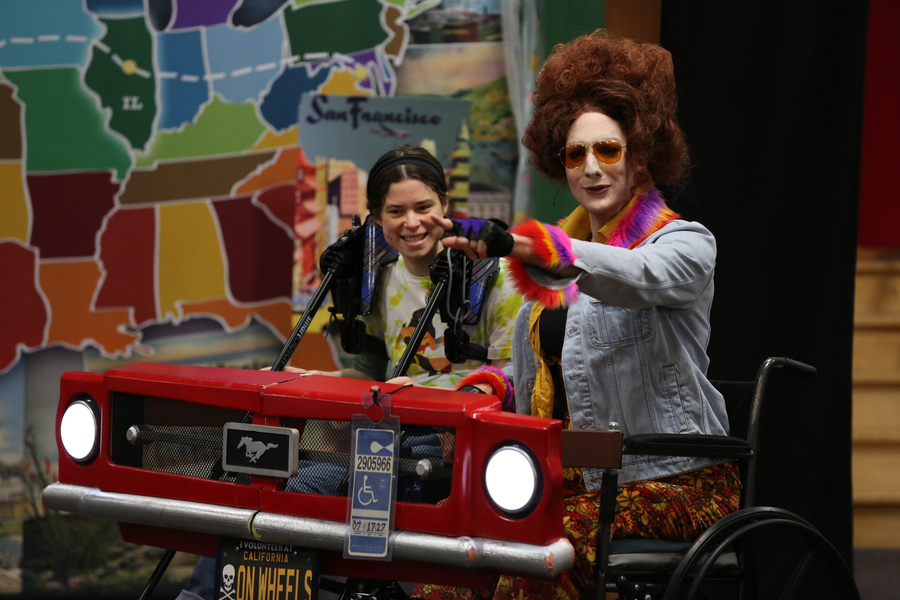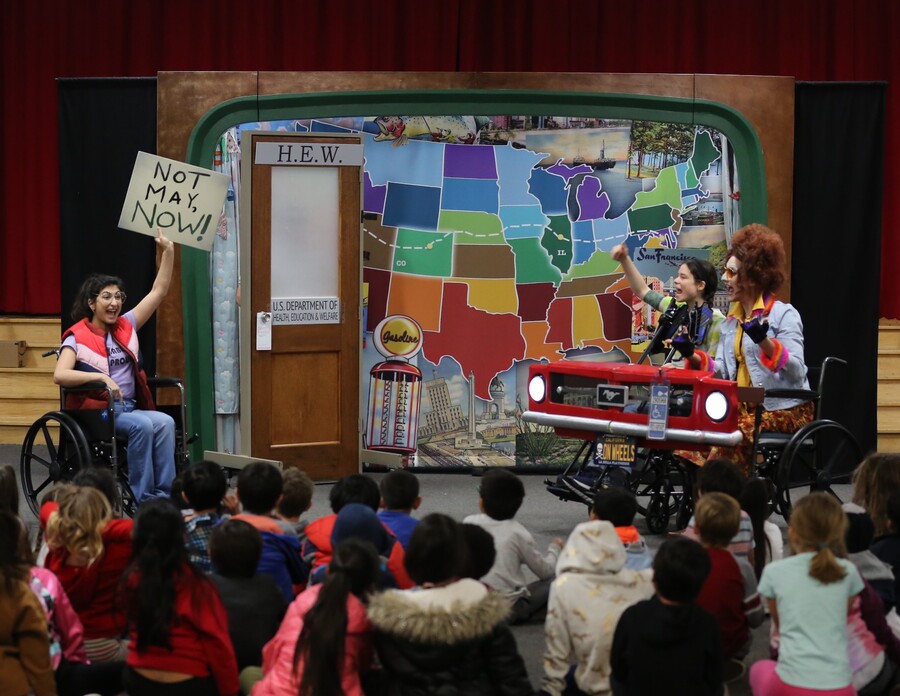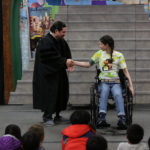This year’s Performance Outreach Program (POP) Tour at La Jolla Playhouse is proving to be an educational experience for everyone involved, not just the students seeing the show. This production of A.A. Brenner and Gregg Mozgala’s commissioned play, Emily Driver’s Great Race Through Time and Space has turned a partnership between La Jolla Playhouse and National Disability Theatre (NDT) into a learning opportunity for all. The collaborative tour will visit 48 San Diego County schools, plus four public performances at community locations, through March 27.
NDT was set up in 2018 by Talleri McRae and Mickey Rowe to create fully accessible theatre and storytelling with professional theatre artists. Their mission to provide a model for accessibility in the arts and culture is grounded in a firm belief in the power of theatrical representation. What would it look like, they wondered, if a theatre company started a dialogue with regional theatres about how to bridge the gap between non-disabled and disabled cultures?
“There are so many disabled artists that are doing great work out there,” says McRae. “Why don’t we give regional theatres that are doing more mainstream, non-disabled, more traditional work the tools to tap into the disability culture that we know exists and is really exciting, awesome, sexy, sophisticated work? That was really the beginning of National Disability Theater—to say, let’s create a dialogue and create space for professional theatre artists with disabilities to be employed.”
A similar conversation with La Jolla led to the creation of Emily Driver. The play follows 12-year-old Emily as she sets off on a time-traveling trip across the country after being denied a request for a needed wheelchair. On her journey, she meets leaders who fought for equal rights for people with disabilities throughout history. It’s an ideal show for 2020, the 30th anniversary of the passing of the Americans with Disabilities Act.
Mozgala and Brenner said the story was inspired by Bobbie Lea Bennett, a disabled transgender woman who drove from San Diego to Washington, D.C., in 1978 to demand that Medicaid pay for gender affirmation surgery. Emily Driver highlights stories like Bennett’s, and other events in the disability rights movement that led up to the signing of the ADA in 1990, including the Denver ADAPT bus protests.
“I’ll be the first to say as a person with a disability, I did not know about any of these events before working on this production,” says Rowe, who is co-directing the POP Tour show with McRae. “As a person with a disability, I did not know my own history because it is not taught in public schools.”
McRae concurs. Being able to look at events like the 504 Sit-in—a disabilities rights protest in 1977 led by Judith Heumann—with this group of artists presented a rare opportunity. “It was exciting for the artists working on the play to kind of rediscover our own history together in the room,” recalls McRae. “Having that community that we don’t often get a chance to have together, and then to share it with a multigenerational audience.”
From top to bottom–directors, designers, writers, and actors—the artistic and design teams on NDT shows are composed of artists with disabilities. Having people with disabilities making the artistic decisions was powerful, and a big departure from anything Rowe had seen professionally in the past.
“Traditionally, when regional theatres think about including disability diversity,” Rowe explains, “what ends up happening is that they cast one actor with a disability in a show directed, designed, and written by non-disabled artists. Which is great, but it doesn’t quite reflect the fact that 20 percent of the population has a disability.”
Hiring disabled people to fill all the jobs on the NDT/La Jolla partnership has effectively created a community. As Rowe explains, it’s not often that people with disabilities are able to have “in-person community” with other people with disabilities. Even at the audition stage, in which some artists were sharing a room with other disabled artists for the first time, was an emotional experience.
To help bring students into this community, La Jolla has provided an online guide for teachers, with pre- and post-show activities encouraging discussion on disability and representation. Additionally, students are given the opportunity to ask questions of the actors themselves after the performance.
“What is so valuable, especially for those children,” Rowe says, “is this might be the first time that they are engaging in conversation with an adult who has a disability. This might be the first time that those kids with disabilities might be seeing a professional in front of them they can give a handshake to, or give a hug to, and have an actual in-person conversation about what it is like being an adult with a disability—seeing that they do have people like them who they can learn from and build community with.”
The impact of this year’s tour is reaching beyond the students. The schools and hosting facilities are learning too. Early on, the POP Tour team found that one of the schools where they were set to do their technical rehearsals and previews didn’t have an accessible stage. La Jolla Playhouse’s education director, Julia Cuppy, recalled the team needing to come up with a new plan to be on the floor instead of the stage. Everything wound up working out, but this event raised awareness with the school district that there need to be ways for wheelchairs to get onto stages and performance areas.
“That itself is an area where a lot of students feel safe,” says Cuppy. “If they can’t even access it, then that keeps them from being able to participate. That relationship with the district has been extremely fruitful in making changes across San Diego county.”
Rowe notes that these occurrences are hardly rare, even within ADA-compliant buildings. “It is so common that when people think that they’re all going to be ADA and make all of their spaces accessible, they think about the audience access, but don’t think about the people who are going to be onstage or behind the stage.”
This became a crucial distinction for NDT and La Jolla as they worked through logistics of the tour, since actors are hired on a Theatre for Young Audiences contract. The Emily Driver team includes four actors who also operate as assistant stage managers. With the help of two crew members, the team tours around San Diego County in a 16-foot truck, unloading the set (in only 60 minutes), performing, then loading the truck back up.
“Going into this, the conversation was, how do we make this tour accessible to any artists that want to be involved?” Cuppy says. “We had to do a lot of prep to make sure that every site that we went to was accessible for our cast and our crew, prior to even sending them there. We then give our production crew an accessibility chart and a plan based on what the environment of that school site is allowing.”

Working through these challenges has allowed for a flood of positive responses from the students in the audiences. La Jolla’s POP Tour, which was founded in 1987, reaches up to 25,000 students, with 70 percent of those students being students of color. In 2019, 74 percent of the performance sites were schools designated as low-income, with at least 50 percent of the students receiving free or reduced lunch. Cuppy says they knew heading into this project that the students would enjoy feeling like they’re participating—especially the section of the play when students help with protest chants.
“They feel like they’re actually making change along with the characters in the story,” says Cuppy. “One student said that they learned that they shouldn’t just be a bystander, they should be an ‘upstander’ and really stand up for equity and rights for all. It’s like, wow. That’s what these young people are leaving the room with. Let’s all be ‘upstanders.’”
The partnership between NDT and La Jolla won’t stop at this POP Tour production. In addition to working with La Jolla on a future co-production with Chicago’s Goodman Theatre, Rowe and McRae are also the current La Jolla artists-in-residence. As La Jolla artistic director Christopher Ashley pointed out, the presence of McRae and Rowe has not only given La Jolla audiences excellent art, it has also provided the company with clarity on how to more adequately handle questions they may have around making theatre for and with people with disabilities.
“Don’t assume you understand what’s happening,” says Ashley. “Always ask. Always communicate. That has been a lesson that a lot of people have taken to heart from working with National Disability Theatre.”
Cuppy agrees, noting that, as an institution, La Jolla knew they could be more inclusive of artists with disabilities, but they wanted to make sure they did so in an appropriate way. “We knew that National Disability Theatre was going to be able to help us do that,” says Cuppy. “We all came to the table having a common goal to make sure that we were providing opportunities for artists with disabilities to be in our story, as well as creating the story. We were in uncharted territory in lots of ways, and we knew it was going to be a challenge.”
While it’s not always easy to ask for help or take on a new challenge, Rowe encourages everyone to not approach this important work with fear. “The biggest thing that others can take away from this in their own work is that we all need to just be brave and jump into the work head first,” he says. “We don’t have to know all of the answers to begin the work.”





